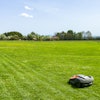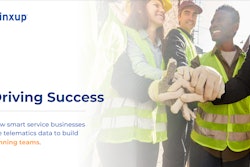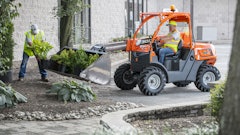
When you’re looking for a telematics solution, you might feel like you’re undertaking a box-checking exercise. You’ve consulted review websites, manufacturers’ materials and media articles and created a comprehensive report card on all the bells and whistles you can find in a provider. However, there’s a problem with this method.
Small and midsize landscape businesses can end up with tech that’s overly complicated. You don’t want a solution that makes your job more difficult as a leader. You can’t manage every metric. You should narrow down the most important ones and create a team culture where your managers and crews are bought into your objectives and understand “the why.” Here’s the data you’ll actually need:
1. Reduce safety risk and coach drivers with AI driver behavior data
You’ve taken care of the obvious liabilities to your business like filing and paying payroll taxes, collecting sales tax and workers’ compensation. One of the next biggest risks is an at-fault accident that could cause you to lose your insurance or come with a lawsuit that could cost you your business. No driver wants to feel like they’re being watched. However, some of the best things you can do for your workers are to make sure they get home safe, provide assurance that they are working for a company that is not putting itself at risk and share the benefits of controlling rising insurance costs.
The amount of safety data available from telematics providers can be overwhelming. Traditional telematics data that most closely correlate with claims dollars are harsh braking and high-speed events. Years ago, you had to manage harsh braking trends because you didn’t know the full story, but now with video, you know exactly what to coach to. AI data coming from a dash cam can detect cellphone use, seatbelt use, tailgating and a variety of other metrics. Many of the "other metrics" are too error-prone or lack the same benefit potential.
Start with a simple program designed to decrease cellphone use (26% of accidents involve cellphone use) and increase seatbelt use. Document your policy, reward drivers for good performance and improvement, enable in-cab alerts, which is the best way to improve behavior, and coach your worst offenders. Assure your drivers that you will not abuse having access to the video day-to-day and stick to it. Highlight the benefits of exoneration from false accusations to help get driver buy-in. Create a “coach, not catch” culture.
2. Improve planning and efficiency with on-site times
Having real and reliable on-site time from GPS that cannot be manipulated by a user from a mobile device is paramount. It fills in the gaps from planning assumptions to data you’re getting from your crews in the field and ultimately informs how you bill your customers and pay your workers.
We know how important the estimation process is, but what if your inexperienced crew is still inefficient and not getting through jobs in a timely manner? Or what if they’re doing additional tasks that haven’t been included in the estimate but are not reporting it back in? Knowing the real story from telematics on-site times (based on the customer geofence entry and exit) allows you to coach workers to be more efficient and estimators to be more complete. You’ll be able to detect when a customer has estimated a cut and edge for 90 minutes, but it’s routinely taking the crew two hours due to unbilled brush pickup at the site.
You’ll also be able to compare GPS on-site data against the timeclock data to coach workers to perform time punches more accurately.
3. Manage day-to-day exceptions with trip reporting data
Trip reporting may be boring, but spending 10 mins on analyzing what happened yesterday can lead to coaching opportunities that save you thousands.
A simple review will highlight long customer visits, long trips and long idle events that can all set the operation for the day back and lead to unnecessary costs. You can use those to ask questions and coach your drivers while it’s still fresh in their minds.
You should also be able to determine if there is any use outside of approved hours, who started later than usual or finished early, visits to unapproved locations that you’ve geofenced and even return trips to company locations for tools.
This habit will increase accountability and help you determine what you need to focus on as a manager. You might need to have an idling policy or get tighter around unauthorized side jobs. You may also uncover some things you can do for your workers so they’re better equipped to serve your customers.
4. See the whole story with equipment tracking, vehicle MPG and utilization data
Paying attention to equipment run times and utilization can be very beneficial to improving performance. If most of your on-site time doesn’t include equipment running, you may have an incorrect bid, workers doing too much busy work at the site or performance issues.
Ideally, you’ll have balanced utilization for equipment and predictable maintenance schedules to keep operations running smoothly. It’s everyone’s job to ensure that’s the case. Tracking utilization helps prevent "hoarding" spare equipment by crews, which can be convenient for crews but detrimental to the business and lead to unnecessary rental costs. In addition to creating preventive maintenance schedules, using diagnostic trouble codes and tracking fuel costs, drivers should communicate when issues arise with their vehicles and be accountable for behaviors that impact vehicle health and life. Tracking performance versus expected MPG can uncover idling or harsh driving that leads to fuel waste.
Spot-checking route replay at sites can lead to coaching inexperienced crews on the most efficient mower path or illustrating better ways to break down a large job into chunks.
Coaching your crews and your back office on these items can ensure optimal vehicle costs and avoid downtime that can ruin the entire operation for a day or multiple days.
5. Use data automation tools to engage with customers and improve their experience.
Customer expectations are changing. More than 60% of customers expect to see when their service provider is arriving and that number is growing as Uber, Doordash and Amazon continue to provide live tracking links. Failure to communicate with customers properly can lead to unprepared sites at the time of job, calls into the back office and truck rolls or canceled jobs. Crews can be coached to send a shareable ETA link that the customer can see when they’re on their way.
Too often it's not clear what work was completed. For landscaping companies that fertilize, it’s not always clear they were there if the customer was not present. For snow removal, it’s tough to prove the service was performed in a blizzard where multiple pushes are required throughout the day.
Managers and supervisors can coach teams to capture details and photos of the work they’re doing while in progress and automatically trigger an email recap along with pictures and helpful information: If a lawn was fertilized, you can add a note to encourage watering-in or if you discovered poison ivy on the perimeter brushwork you can offer identification tips. Office staff can set up automated emails in a variety of templates and set them up to send to the customer automatically when the crew leaves. The goal is to make it easy for the driver so they can get on to their next job. You want your team focused on servicing your customers, not writing up long reports.
Customer communication leads to retention and loyalty, word-of-mouth recommendations and add-on services. Coaching your crews to make this a priority is important for the health of your customer relationships.



















![New 2025 Hybrid Power Source[1]](https://img.greenindustrypros.com/mindful/acbm/workspaces/default/uploads/2025/05/new-2025-hybrid-power-source1.15TRTdfJrH.jpg?ar=16%3A9&auto=format%2Ccompress&fit=crop&h=135&q=70&w=240)